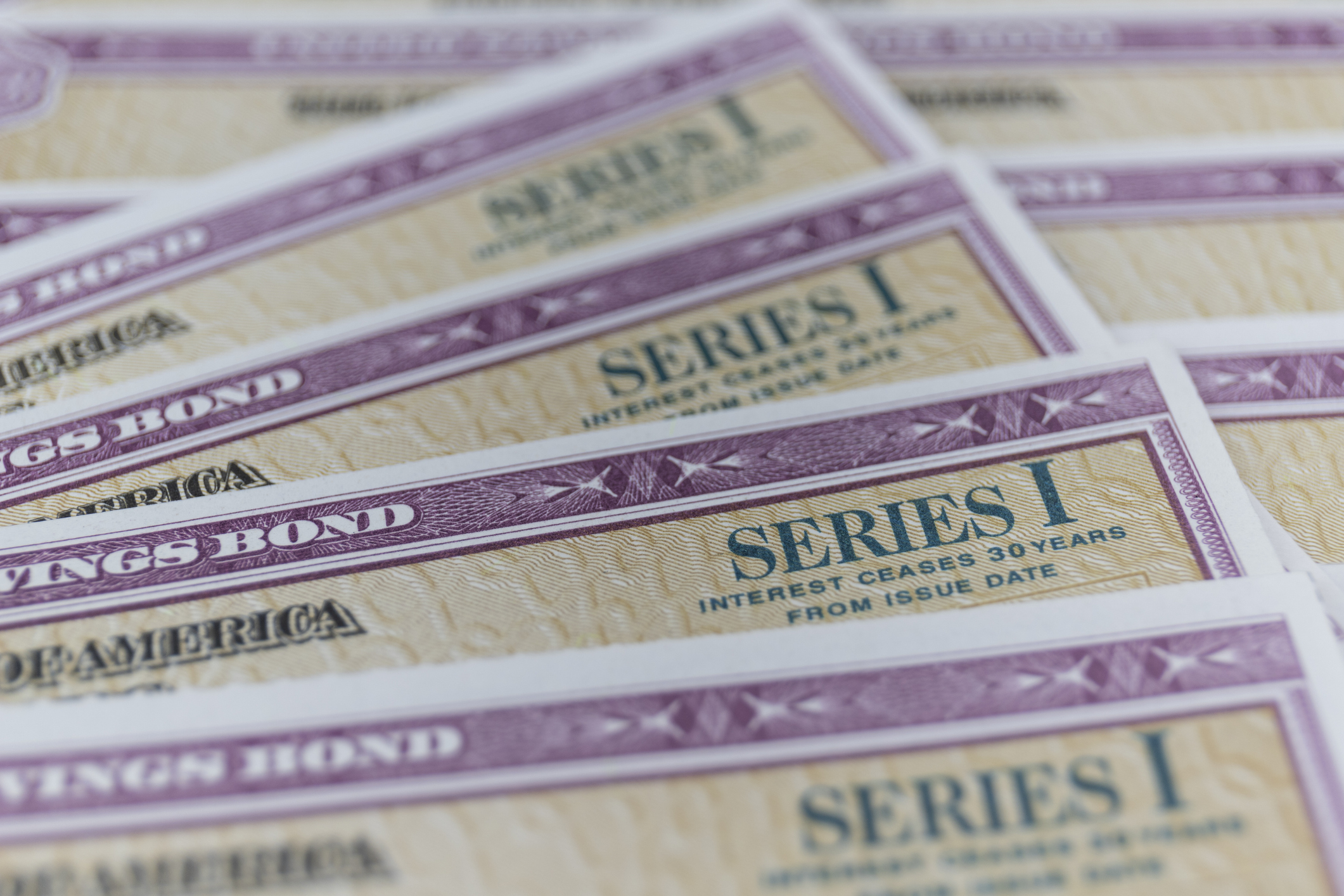
Two years ago we wrote a blog article that encouraged purchasing I bonds because they were yielding over 9% at the time. If you are still holding I bonds purchased during that time period, it is time to reevaluate your holdings. Since that six month time period in 2022 when the interest rate on I bonds was 9.62%, the six month rates for I bonds purchased in 2022 have decreased to 6.48%, then 3.38%, 3.94% and now 2.96%. Considering high yield savings accounts and money market accounts can easily be found paying above 5%, does it make sense to continue holding I bonds purchased in 2022? It depends.
An I bond is a bond issued by the US government on which you earn interest at a rate tied to inflation and guaranteed by the federal government. If you buy an I bond today (June 2024), you will earn 4.28% interest, which is tied to the Consumer Price Index (CPI-U). You can also defer paying federal tax on the interest until you redeem (cash in) the bond, and there is no state or local tax on the interest.
You have the potential to accumulate a significant number of I bonds over the course of time and make them part of the fixed income portion of your investment portfolio. Since the rate of return will always be equal to inflation (plus a possible fixed component), you can use I bonds as the hedge against the inflation portion of your retirement savings.
There are two components to the interest rate you receive on an I bond. There is a "fixed rate" that is set when you buy the bond and does not change for the life of the I bond. The fixed rate is often 0% but in the last year has increased from .40% to .90% and is now 1.30% (as of June 2024). In addition, there is a variable interest rate on the I bond changes every six months (in May and November) to match the current inflation rate. The combined inflation and fixed rate will never be less than 0%, even if the United States experiences deflation (negative CPI-U).
The current total composite interest rate on new I bonds (as of June 2024) is 4.28%. When I bonds were paying 9.62% in 2022, this was all the variable rate and there was no fixed rate component (possibly because the Fed didn't need to entice borrowers with a fixed rate because demand was so high). The last time that the fixed rate was this high was in 2007 when it reached 1.40%.
Individuals who bought I bonds in 2022 and are still holding them are currently only getting the variable rate of 2.98% and a 0% fixed rate. This 0% fixed rate stays with the bonds for their entire life up to 30 years. If you cash out those older I bonds to buy new ones, you will benefit from the 1.30% fixed rate over the long run.
When deciding whether or not to cash in I bonds that were purchased in 2022 there are a few things to consider.
I Bond Purchase Limitations ($10,000 Cap)
If you are in the habit of buying I bonds as part of your overall investment strategy, you know that I bond purchases are currently limited to $10,000 / year in purchases per Social Security Number (SSN) or Tax Identification Number (TIN). For example, if you are married with two children, you could purchase up to $40,000 ($10,000 for each person) in I bonds. Depending on the dollar value of I bonds that you plan on purchasing every year and for how many SSNs / TINs you are using, you may be limited annually to what you can redeem of current I bonds to upgrade to new issues.
If you already bought I Bonds in 2024 or if you have more than $10,000 worth of I Bonds at 0% fixed rate, you might not be able to switch all of them to new ones by buying new I bonds.
It is also important to know that I bonds that have been held for more than one year can be redeemed at any time but will give up 3 months' worth of interest. However, the upgraded fixed interest rate of 1.30% will quickly (about 6 months) make up for the penalty with the higher interest.
Market Rates for other Cash Accounts
If you purchased I bonds in 2022, at that time the interest rate was much higher than any other returns from high yield savings and money market accounts. That is no longer the case. Current interest rates in high yield savings accounts are around 5% (as of June 2024). If the only purpose for buying I bonds in 2022 was for the great interest rate, you could consider cashing them in and reallocating to a money market or high yield savings account.
Tax Considerations
Interest earned on I bonds is subject to federal income tax but not state or local income tax. The interest earnings can be reported annually or deferred until you redeem the bond or it reaches its full maturity after 30 years.
You will pay federal income tax on the interest earned when you cash out I bonds unless you chose to pay tax annually. The 3-month early withdrawal penalty doesn't count as interest earned because you never received it so you won't pay tax on the early withdrawal penalty.
You will add the interest to your tax return using the 1099 form from TreasuryDirect. Remember to download or print the 1099 form from TreasuryDirect in January. It's under ManageDirect -> Manage My Taxes. TreasuryDirect sends an email notification when the 1099 form is available but they won't send the form by mail.
Treasury Direct
You can check the current status of your previously purchased I bonds on the Treasury Direct website . After logging in, click on Savings Bonds then you will see your Series I bonds listed under Savings Bonds.
Gifting I bonds
You can buy I bonds for others, such as children or grandchildren , either electronically or in paper form. If you want to do it electronically, you must have a Treasury Direct account and the recipient's full name and Social Security number. Electronic purchases of I bonds are subject to the $10,000 / year individual limit. Getting paper I bonds as gifts must be done through the federal tax refund process mentioned earlier and is limited to giving bonds to two people per year.
Beneficiaries
Beneficiaries for I bonds are assigned for each registration that you have purchased. If you have bought all of your I bonds in one transaction, you only have one registration. If you have set up a periodic purchase plan for buying I bonds or bought different amounts over time, then you could have many registrations because each purchase counts as a separate registration.
Only one beneficiary can be assigned to each registration, so if you have multiple individuals whom you would like to have as beneficiaries, then you have to assign each to a different registration(s) in the breakdown that you feel is appropriate. Or, if you have a trust that already accomplishes this for you, you can assign the trust as the beneficiary of all the I bonds.
Changing beneficiaries is cumbersome and must be done individually for each registration on the Treasury Direct site. You can and should assign one or more beneficiaries to each I bond—that way, the bond can be inherited directly without having to go through probate. You can change the beneficiary whenever you want.
Wrap-up
I bonds are a very under-utilized savings vehicle offered by the U.S. Treasury. They aren't right for everyone, but they can be another tool in your financial toolbox. If you are interested in learning more about how to purchase I bonds, whether you should cash in your I bonds, or whether they are right for your financial situation, please reach out to our team.
Disclaimer: This is not to be considered investment, tax, or financial advice. Please review your personal situation with your tax and/or financial advisor. Milestone Financial Planning, LLC (Milestone) is a fee-only financial planning firm and registered investment advisor in Bedford, NH. Milestone works with clients on a long-term, ongoing basis. Our fees are based on the assets that we manage and may include an annual financial planning subscription fee. Clients receive financial planning, tax planning, retirement planning, and investment management services and have unlimited access to our advisors. We receive no commissions or referral fees. We put our client’s interests first. If you need assistance with your investments or financial planning, please reach out to one of our fee-only advisors. Advisory services are only offered to clients or prospective clients where Milestone and its representatives are properly licensed or exempt from licensure. Past performance shown is not indicative of future results, which could differ substantially.



